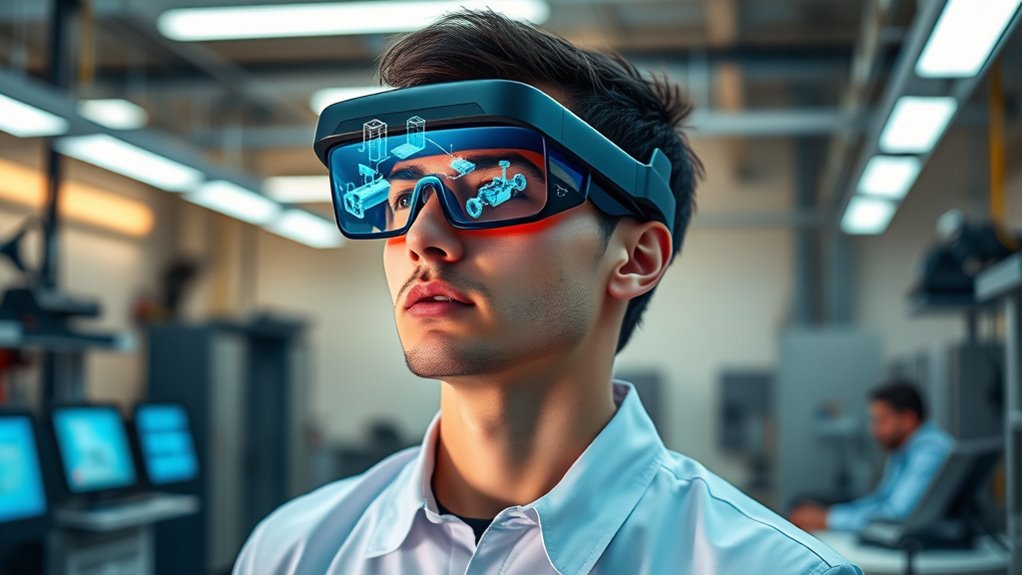Augmented reality transforms staff training by offering immersive, hands-on experiences that boost engagement, safety, and skill development. You can use AR to follow real-time instructions, perform maintenance, or simulate hazards without risks. It enhances learning efficiency, personalizes programs, and reduces costs. While challenges like costs and tech limitations exist, future trends point to more accessible, AI-driven AR solutions. Keep exploring to discover how these innovations can revolutionize your workforce training approach.
Key Takeaways
- AR transforms traditional training into immersive, interactive experiences that enhance engagement and retention.
- It allows realistic simulation of complex procedures and hazardous scenarios without real-world risks.
- AR supports personalized, scalable training programs that improve skill acquisition efficiency across diverse workforce needs.
- Implementation involves planning, piloting, training, and continuous evaluation to maximize engagement and operational benefits.
- Future trends include more affordable hardware, AI integration, and increased adoption for competitive workforce development.
The Evolution of Staff Training With AR Technology

The evolution of staff training with AR technology has transformed how organizations prepare their employees. You no longer rely solely on textbooks or classroom sessions; instead, AR offers immersive, hands-on experiences. Initially, training was passive, with learners absorbing information through lectures or manuals. Now, AR allows you to interact with realistic simulations, making learning more engaging and effective. You can practice complex procedures without real-world risks, gaining confidence before handling actual tasks. As AR technology advances, it becomes more accessible and integrated into daily workflows, enabling continuous learning. This shift streamlines onboarding, reduces training costs, and accelerates skill development. Ultimately, AR’s evolution empowers you to learn faster, retain more information, and perform better in your role. Content awareness is essential to ensure that training remains aligned with organizational goals and user needs.
Key Benefits of Using AR in Employee Development

Implementing AR in employee development offers numerous advantages that can markedly enhance your learning experience. It provides immersive, hands-on practice without real-world risks, boosting confidence and retention. AR also accelerates skill acquisition by simulating real scenarios, saving time and resources. Additionally, it enables personalized training, adapting to individual learning paces and styles. Necessary cookies ensure the proper functioning of the site during training sessions.
Types of AR Applications in the Workplace

Augmented reality applications in the workplace come in various forms, each tailored to specific training needs and operational goals. You can leverage different AR tools to improve efficiency and safety. Here are some common types:
Augmented reality enhances workplace training and operations with diverse, tailored tools for safety and efficiency.
- Instructional Guides: Step-by-step overlays that show how to assemble or repair equipment in real-time.
- Maintenance Support: AR apps that guide technicians through complex troubleshooting procedures.
- Product Visualization: Visualize products or parts in 3D to understand design or assembly processes better.
- Remote Assistance: Connect with experts who can see your workspace and provide guidance instantly.
These applications help you learn faster, reduce errors, and improve overall productivity by integrating digital information seamlessly into your physical environment.
Enhancing Safety and Compliance Through AR Simulations
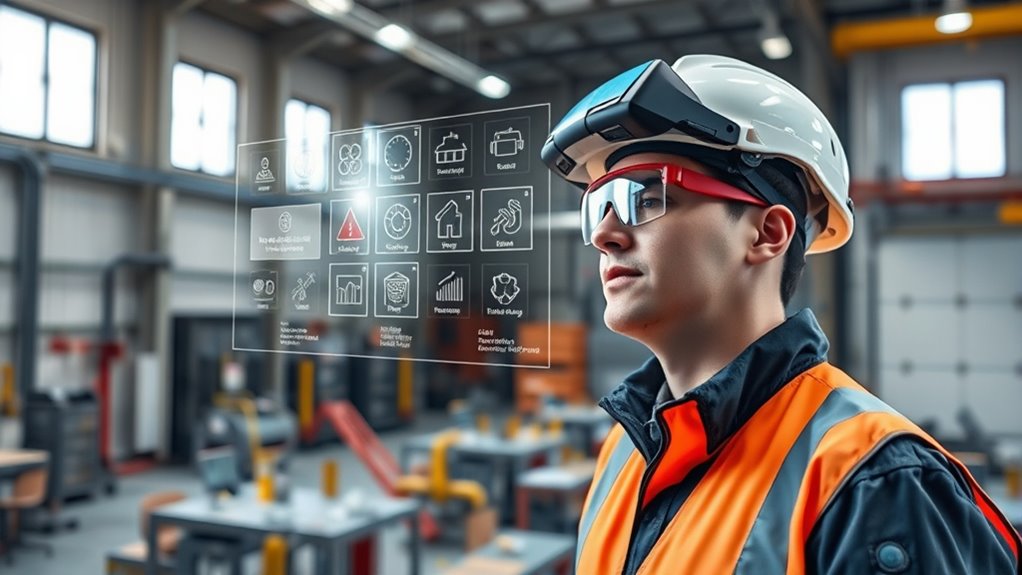
You can enhance safety and compliance by using AR simulations that mimic real-world hazards and procedures. These realistic safety drills help staff respond confidently in critical situations. Additionally, compliance scenario simulations ensure employees understand regulations and avoid costly mistakes. Incorporating training hours data can optimize scheduling and ensure staff are adequately prepared.
Realistic Safety Drills
Realistic safety drills are essential for preparing staff to respond effectively during emergencies, and augmented reality (AR) takes these drills to a new level of engagement and accuracy. With AR, you can simulate real-world scenarios without risking safety, allowing staff to practice responses in a controlled environment. This immersive approach helps identify weaknesses and build confidence. AR safety drills can:
- Create highly detailed, interactive scenarios tailored to specific risks
- Enable real-time feedback for immediate learning
- Allow repeated practice without logistical challenges
- Mimic unpredictable elements to test adaptability
- Incorporate high contrast ratios to enhance image clarity and immersion during simulations
Compliance Scenario Simulations
While traditional compliance training can be tedious and sometimes ineffective, AR simulations make it engaging and impactful. With AR, you can immerse yourself in realistic scenarios that replicate everyday compliance challenges, like handling hazardous materials or responding to emergency procedures. These simulations allow you to practice decision-making in a safe environment, helping you understand the consequences of your actions without real-world risks. You’ll receive instant feedback, which reinforces proper protocols and highlights areas for improvement. This active learning approach boosts retention and confidence, ensuring you’re better prepared for actual compliance situations. Incorporating interactive learning techniques like AR transforms passive training into an engaging experience that improves safety, reduces errors, and promotes a culture of compliance.
Customizing Training Programs With Augmented Reality
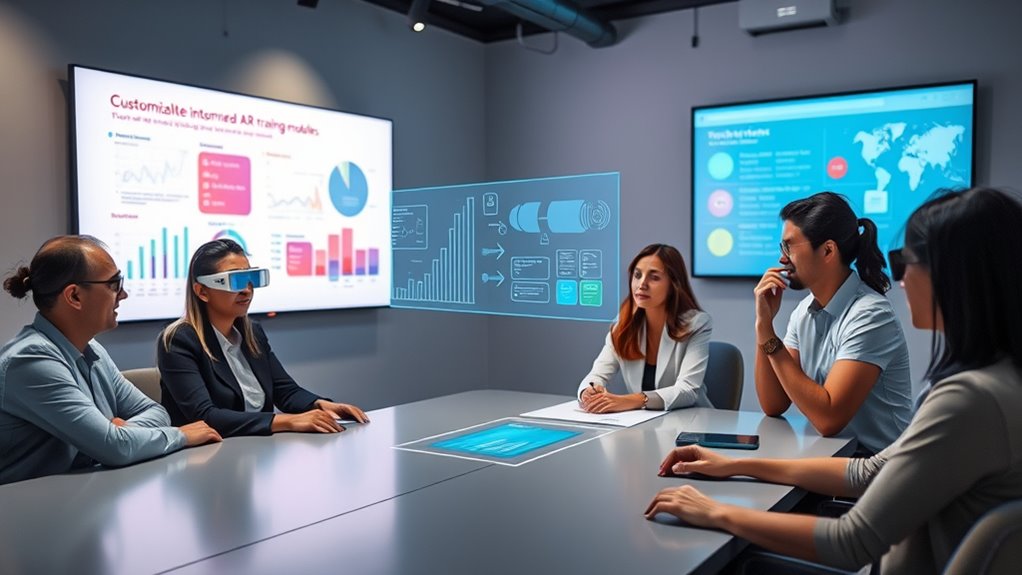
By leveraging augmented reality (AR), organizations can tailor training programs to meet the specific needs of individual employees or departments. AR allows you to customize content, ensuring relevance and engagement. You can adapt scenarios based on skill levels, job roles, or performance gaps, making training more effective. Additionally, AR enables real-time feedback, so learners can focus on areas needing improvement. You can also update modules quickly, reflecting new procedures or regulations without overhauling entire programs. Incorporating customizable designs like those found in diverse indoor planters demonstrates how adaptable visual elements can enhance training environments and engagement.
Challenges and Limitations of AR-Based Training
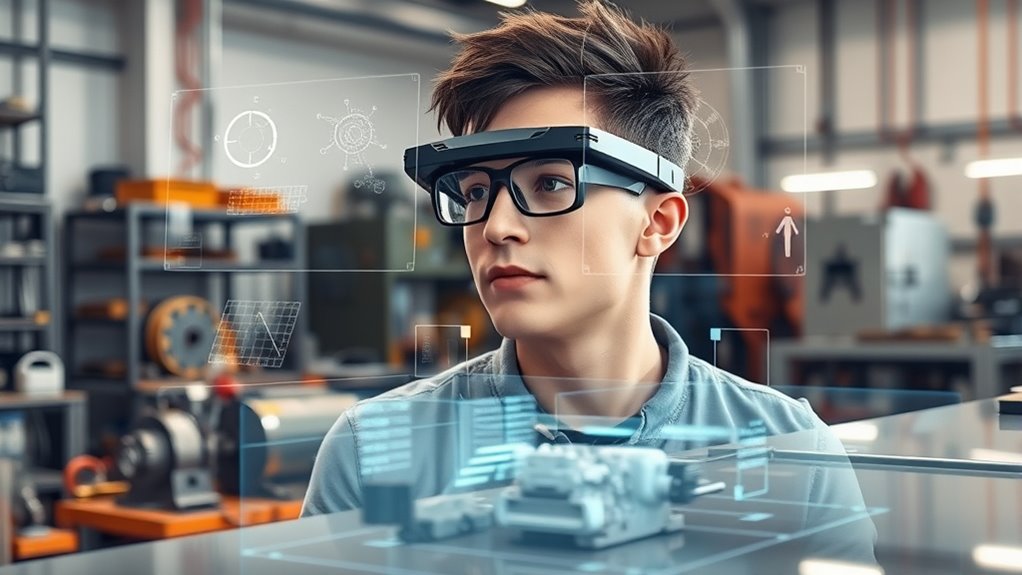
Implementing AR-based training presents several challenges that organizations must address. First, the cost of developing high-quality AR content and acquiring suitable hardware can be substantial, making it difficult for smaller companies to invest. Technical issues also pose hurdles; you might encounter hardware limitations, software bugs, or connectivity problems that disrupt training sessions. Additionally, user acceptance can be a concern—if staff aren’t comfortable with new technology, engagement drops. Compatibility issues may arise across different devices or operating systems, complicating deployment. Moreover, AR training often requires significant time and expertise to design effectively. Lastly, safety considerations must be addressed, especially in environments where physical hazards exist, to prevent accidents during immersive experiences. Overcoming these challenges is essential for successful AR integration. Introducing proper storage solutions for digital content can also help streamline updates and maintenance, ensuring consistent training quality.
Future Trends in AR for Workforce Education
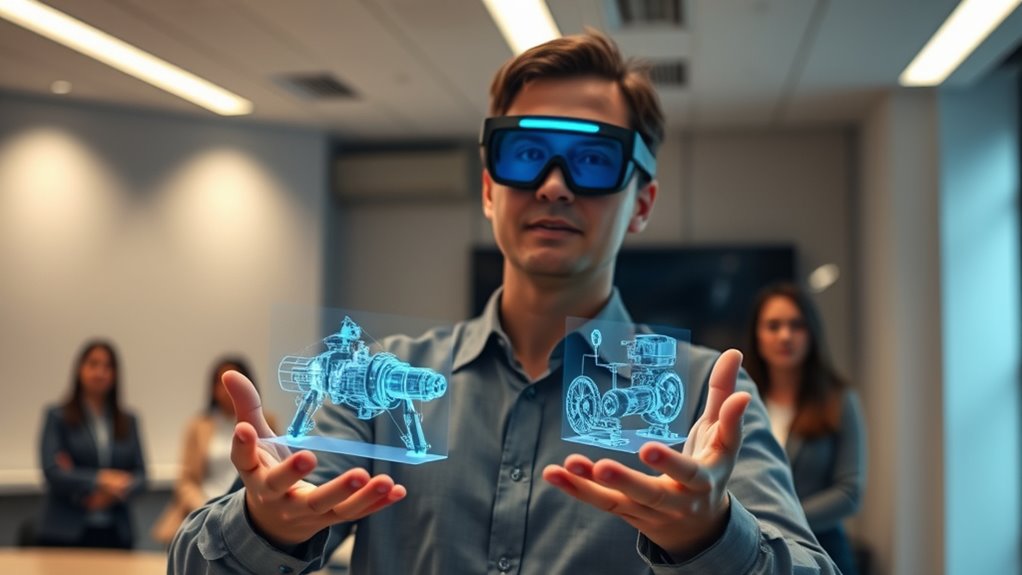
Advances in technology and increasing investments in workforce development signal exciting possibilities for the future of AR in training. You can expect AR to become more immersive, blending virtual and real-world environments seamlessly. Personalization will also improve, allowing tailored learning experiences that adapt to individual needs. Collaboration features will enable remote teams to work together more effectively within AR spaces. Additionally, AI integration will enhance AR applications, making real-time feedback and guidance smarter and more responsive. As AR hardware becomes more affordable and accessible, organizations will adopt these tools faster. These trends will make training more engaging, efficient, and scalable, helping your workforce stay competitive in an evolving landscape. Furthermore, understanding the playground hours of nearby entertainment parks can help organizations plan team outings or training retreats effectively.
Implementing AR Solutions: Best Practices for Organizations
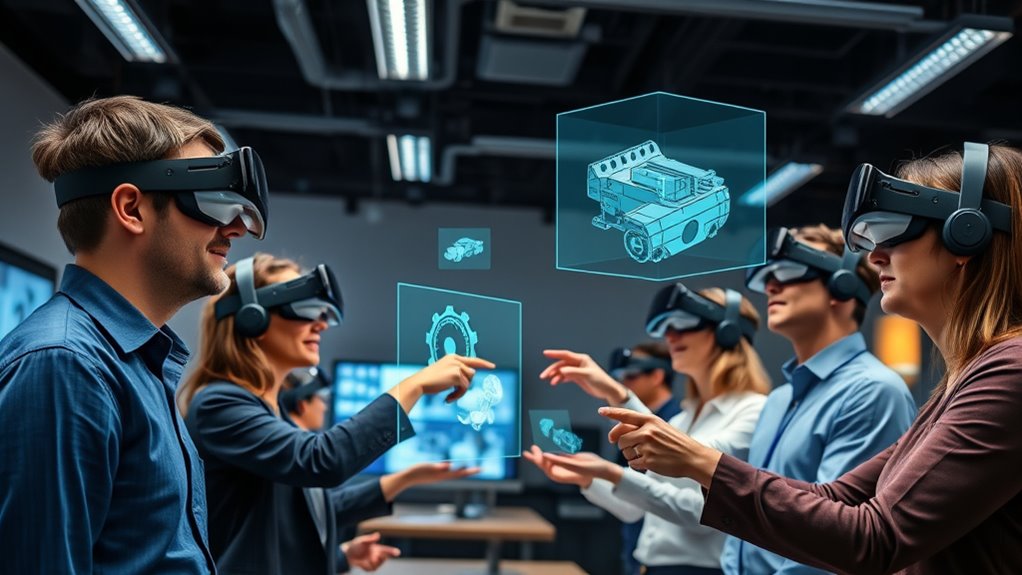
To successfully adopt AR solutions, organizations must start with clear goals and a thorough understanding of their training needs. Define specific objectives, such as reducing onboarding time or improving safety procedures. Assess your current training processes to identify gaps AR can fill effectively. Involve key stakeholders early to ensure buy-in and smooth integration. Choose the right AR technology that aligns with your workforce’s skills and the tasks at hand. Pilot your solutions with a small group to gather feedback and make adjustments. Provide comprehensive training for trainers and staff to maximize engagement. Regularly evaluate AR’s impact on performance and adapt your approach as needed. Additionally, fostering an imaginative mindset can enhance creative problem-solving during implementation. Following these best practices ensures a seamless implementation that enhances learning outcomes and operational efficiency.
Frequently Asked Questions
How Cost-Effective Is AR Training Compared to Traditional Methods?
You’re wondering how cost-effective AR training is compared to traditional methods. AR can be more affordable in the long run because it reduces the need for physical resources, travel, and instructor costs. Plus, it offers immersive, repeatable learning experiences that boost retention. While initial setup might seem expensive, the ongoing savings and improved training outcomes often make AR a smarter investment, especially for large or complex organizations.
What Industries Benefit Most From Ar-Based Staff Training?
Imagine a factory floor where workers easily visualize complex machinery, or a hospital where nurses practice procedures virtually. You’ll find industries like manufacturing, healthcare, and aviation benefit most from AR-based staff training. These fields handle intricate tasks that require precision and safety. By integrating AR, you make training more interactive and effective, helping staff gain hands-on experience quickly and confidently, ultimately improving performance and safety outcomes.
How Do Employees Typically Respond to AR Training Programs?
You might find that employees often respond positively to AR training programs, as they find the immersive experience engaging and interactive. Many appreciate how AR makes learning more hands-on, helping them grasp complex concepts faster. However, some may initially feel hesitant or overwhelmed by new technology, but with proper guidance, most adapt quickly. Overall, AR training can boost motivation, confidence, and retention, leading to improved performance in your organization.
What Hardware Requirements ARe Necessary for AR Training Setups?
When setting up AR training, you need to verify you have the right hardware. You’ll require AR headsets or smart glasses, like HoloLens or Magic Leap, to deliver immersive experiences. A compatible device, such as a powerful tablet or smartphone, can also work for simpler applications. Additionally, a reliable Wi-Fi connection, sufficient processing power, and a compatible operating system are essential to run AR software smoothly.
How Is Data Privacy Managed in AR Training Applications?
Imagine a scene straight out of a sci-fi film—your AR training app collecting data. You manage privacy by encrypting data during transmission and storage, ensuring only authorized personnel access it. Regular audits and compliance with privacy laws like GDPR or HIPAA keep your data secure. You also implement user consent protocols, giving staff control over their information. These steps help protect sensitive data while providing effective AR training experiences.
Conclusion
While augmented reality transforms your staff training with immersive, interactive experiences, it also highlights the importance of adaptability and ongoing learning. As technology advances, embracing AR can elevate safety and efficiency—yet it reminds you that no tool replaces the need for human judgment and flexibility. In this evolving landscape, AR is both a powerful ally and a catalyst for continuous growth, urging you to balance innovation with core skills for lasting success.
